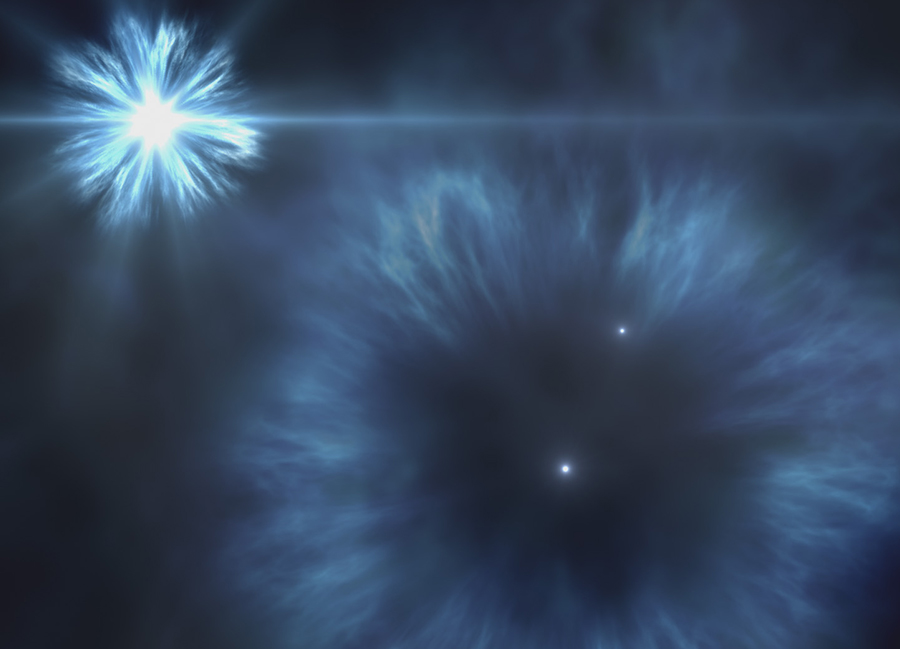Large Amounts of Oxygen Detected in Ancient Star’s Atmosphere
Published Date
By:
- Cynthia Dillon
Share This:
Article Content
This animation illustrates the earliest epoch of our universe, just after the Big Bang, when the first elements of hydrogen, helium and lithium were created in the still hot cosmos. These atoms eventually collected to form the first generation of massive stars, which in turn produced heavier elements such as carbon, oxygen and nitrogen. As these massive stars exploded as supernovae, they released these heavier elements into the universe, eventually collecting on next generation stars such as J0815+4729. Video courtesy of Gabriel Pérez, SMM (IAC); IACVideos, YouTube
An international team of astronomers from the University of California San Diego, the Instituto de Astrofísica de Canarias (IAC) and the University of Cambridge have detected large amounts of oxygen in the atmosphere of one of the oldest and most elementally depleted stars known—a primitive star scientists call “J0815+4729.” This new finding, reported in The Astrophysical Journal Letters, provides an important clue about how oxygen and other important elements were produced in the universe’s first generations of stars.
After hydrogen and helium, oxygen is the third most abundant element in the universe and important to all life forms on Earth. It serves as a chemical basis of respiration and a building block of carbohydrates, as well as the main element in the Earth’s crust. Absent from the early universe, it emerged through nuclear fusion reactions that occurred deep inside the most massive stars—stars roughly 10 times or more massive than the sun.
To trace this early production of oxygen and other elements, astronomers study the oldest existing stars. J0815+4729 is one of them. It was first discovered by the IAC team in 2017 using the Grand Canary Telescope in La Palma, in the Canaries, Spain. It resides over 5,000 light years away toward the constellation Lynx.
“Stars like J0815+4729 are referred to as halo stars,” explained UC San Diego Professor of Physics Adam Burgasser, a co-author of the study. “This is due to their roughly spherical distribution around the Milky Way, as opposed to the more familiar flat disk of younger stars that include the sun.”

Artistic image of the supernova explosions of the first massive stars that formed in the Milky Way. The star J0815+4729 was formed from the material ejected by these first supernovae. Image courtesy of Gabriel Pérez, SMM (IAC).
Halo stars like J0815+4729 are truly ancient stars, allowing astronomers a peek into the universe’s early history of element production. The research team observed J0815+4729 with the W. M. Keck Observatory’s Keck I 10-meter telescope on Mauna Kea, Hawaii, using a high resolution spectrograph called HIRES. The data, which required more than five hours of staring at the star over a single night, were used to measure the abundances of 16 chemical species in the star's atmosphere, including oxygen.
“The primitive composition of the star indicates that it was formed during the first hundreds of millions of years after the Big Bang, possibly from the material expelled from the first supernovae of the Milky Way,” said Jonay González Hernández, an IAC Ramón y Cajal postdoctoral researcher and lead author of the study.
The chemical composition of the star was found to be very unusual. While it has relatively large amounts of carbon, nitrogen and oxygen, approximately 10, 8 and 3 percent of the abundances measured in the sun, other elements like calcium and iron have abundances around one millionth that of the sun.
“Only a few such stars are known in the halo of our galaxy, but none have such an enormous amount of carbon, nitrogen and oxygen compared to their iron content,” said David Aguado, a postdoctoral researcher at the University of Cambridge and co-author of the study.
The search for stars of this type involves dedicated projects that sift through hundreds of thousands of stellar spectra to uncover a few rare sources like J0815+4729 and follow-up observation to measure their chemical composition. This star was first discovered in data obtained with the Sloan Digital Sky Survey (SDSS).
According to Rafael Rebolo, IAC director and co-author of the paper, the institute began studying the presence of oxygen in the oldest stars of the galaxy 30 years ago, with results indicating that this element was produced enormously in the first generations of supernovae.
“However, we could not imagine that we would find a case of enrichment as spectacular as that of this star,” Rebolo noted.
The researchers acknowledge Heather Hershley and Sherry Yeh at Keck Observatory for their assistance with the observations; financial support from the Spanish Ministry of Science, Innovation and Universities (MICIU) under the 2013 Ramón y Cajal program (RYC-2013-14875); the Spanish Ministry project MICIU (AYA2017-86389-P) and Leverhulme Trust.
UC San Diego’s Department of Physics in the Division of Physical Sciences offers one of the top graduate programs in the U.S. Many of its faculty are active at the Center for Astrophysics and Space Sciences (CASS), an interdisciplinary research unit for research and graduate study in astronomy, astrophysics and space sciences. Areas of specialization include high-energy astrophysics, optical and ultraviolet astronomy, infrared astronomy, radio astronomy, theoretical astrophysics, cosmology, solar physics, space plasma physics, interferometry and astronomical instrumentation.
Share This:
Stay in the Know
Keep up with all the latest from UC San Diego. Subscribe to the newsletter today.



